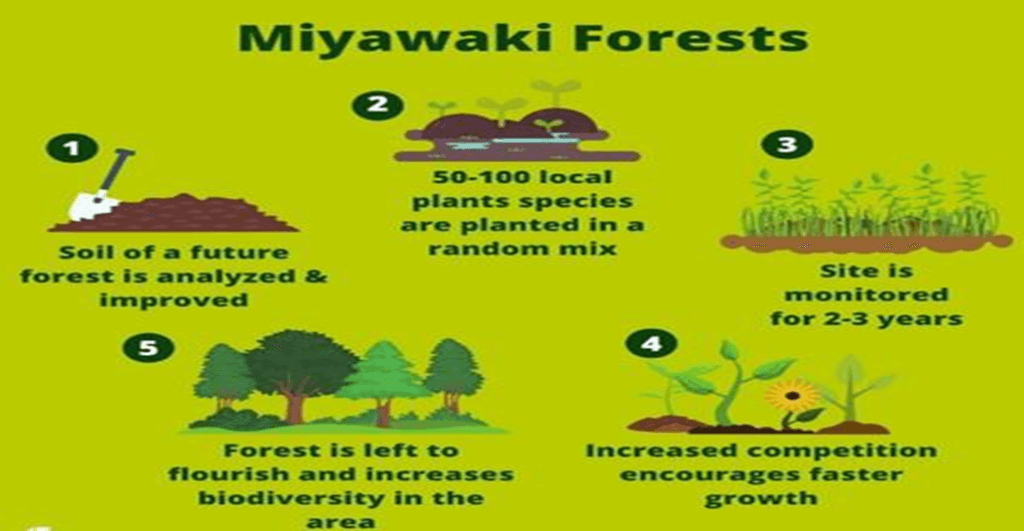During a recent episode of the ‘Mann ki Baat,’ the Prime Minister of India highlighted the Miyawaki plantation method, which is a Japanese technique for establishing dense urban forests within limited areas. We will explain the Miyawaki plantation method, its significance, and its implementation in Mumbai, India.
What is the Miyawaki Plantation Method?
Named after the renowned Japanese botanist Akira Miyawaki, the Miyawaki plantation method involves the strategic planting of two to four different types of indigenous trees within every square meter. Developed in the 1970s, the primary objective of this method is to enhance the density of green cover in small parcels of land. The trees in Miyawaki forests become self-sustaining and reach their full height within three years. Notably, the plants used in this method are predominantly self-sustaining and do not require regular maintenance like watering and manuring. Some commonly used indigenous plants in India for Miyawaki forests include Anjan, Amala, Bel, Arjun, and Gunj.
Significance of Miyawaki Plantations:
The dense green cover provided by indigenous trees in Miyawaki forests offers several benefits to the surrounding environment. Firstly, these trees play a crucial role in absorbing dust particles, thereby improving air quality. Additionally, the presence of Miyawaki forests aids in regulating surface temperature, creating a more favorable microclimate. Furthermore, these forests encourage the development of new biodiversity, fostering the growth of an ecosystem that increases soil fertility and further contributes to temperature regulation.
Mumbai’s Miyawaki Plantation Experiment:
In Mumbai, the Miyawaki plantation method has gained significant traction, with the establishment of 64 Miyawaki forests to date. This initiative was launched under the urban forest project in 2020, and the first such forest was created in Bhakti Park at Chembur in the eastern suburbs. The largest Miyawaki forest in Mumbai is located in Chandivali’s Nahar Amrut Shakti Udyan, spanning over 13 acres and featuring more than 41,000 plants. This ambitious project exemplifies the city’s commitment to green spaces and sustainable development.

Important Points:
- The Miyawaki plantation method involves planting two to four different types of indigenous trees within every square meter.
- The method was developed in the 1970s to densify green cover in small areas.
- The trees in Miyawaki forests become self-sustaining and reach their full height within three years.
- Plants used in Miyawaki forests are mostly self-sustaining and require minimal maintenance.
- Indigenous plants commonly used in India for Miyawaki forests include Anjan, Amala, Bel, Arjun, and Gunj.
- Miyawaki forests help absorb dust particles and improve air quality.
- They also regulate surface temperature and create a favorable microclimate.
- Miyawaki forests encourage the development of new biodiversity and ecosystems, enhancing soil fertility.
- Mumbai has implemented the Miyawaki plantation method with the establishment of 64 Miyawaki forests.
- The first Miyawaki forest in Mumbai was created in Bhakti Park at Chembur.
- The largest Miyawaki forest in Mumbai spans over 13 acres at Chandivali’s Nahar Amrut Shakti Udyan, featuring more than 41,000 plants.
- The Miyawaki plantation method in Mumbai demonstrates the city’s commitment to green spaces and sustainable development.
- The success of Miyawaki forests showcases the effectiveness of this method in enhancing urban environments.
Why In News
During his latest ‘Mann ki baat’ episode, the Prime Minister of India passionately highlighted the transformative potential of Miyawaki plantation, an innovative Japanese technique that enables the creation of lush urban forests within limited spaces. The Prime Minister emphasized the importance of adopting such sustainable practices to enhance biodiversity, combat climate change, and create greener and healthier environments for future generations.
MCQs about The Miyawaki Plantation Method
-
What is the primary objective of the Miyawaki plantation method?
A. Enhancing biodiversity
B. Creating dense urban forests
C. Reducing air pollution
D. Conserving water resources
-
Which of the following is NOT a benefit of Miyawaki forests?
A. Absorbing dust particles
B. Regulating surface temperature
C. Requiring regular maintenance
D. Fostering biodiversity
-
Where was the first Miyawaki forest in Mumbai created?
A. Bhakti Park
B. Chandivali
C. Nahar Amrut Shakti Udyan
D. Chembur
-
What is the significance of Miyawaki forests in regulating temperature?
A. Increasing humidity levels
B. Reducing heat island effect
C. Controlling rainfall patterns
D. Enhancing air circulation
Boost up your confidence by appearing our Weekly Current Affairs Multiple Choice Questions
![]()


